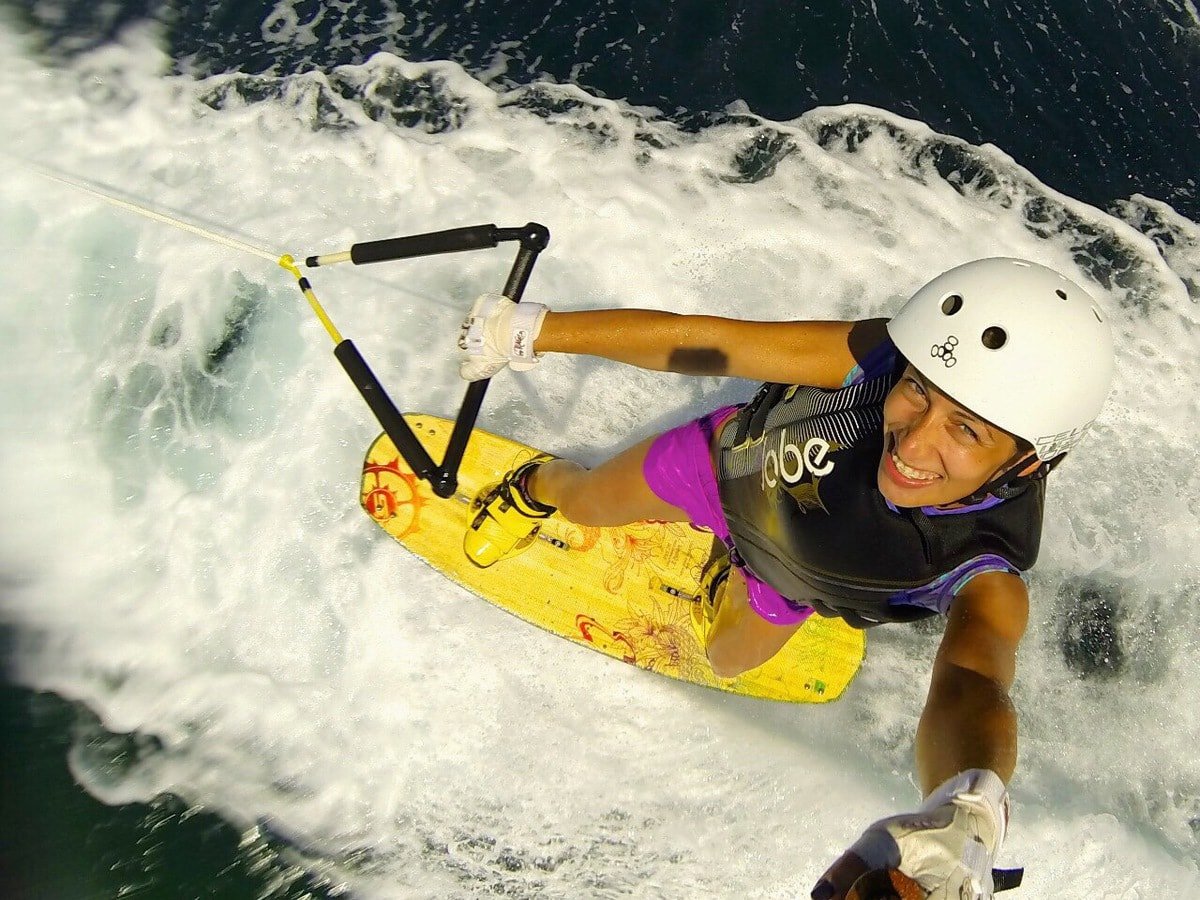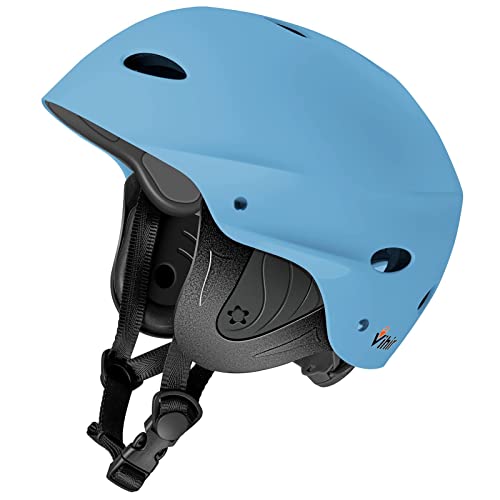Should You Wear A Helmet When Wakeboarding?
If you find yourself wondering, “Are helmets necessary for this sport?” the answer is yes. You really shouldn’t ride without one. Just like a seatbelt in a car, a wakeboarding helmet is your first line of defense for protecting your most important asset – your brain.
As a recreational activity, wakeboarding is loads of fun, but it requires great skill. This extreme sport has the potential to cause some serious injuries if you fail to take precautions.
How We Got Our Answer
We looked at what wakeboarding consists of, what equipment you need to start, helmet types, materials, etc. Most importantly, to ensure that you don’t suffer from any head injuries during your water sport adventures, we researched for hours to inform people about proper safety and protection while enjoying themselves.
While this risk of injury may seem intimidating, there are ways to stay safe while you wakeboard.
What is Wakeboarding?
Wakeboarding involves riding a wakeboard over the surface of a body of water. The rider holds on to rope behind the boat using a tow rope attached to the rider’s waist and propels herself through the water using their hands. It is similar to water skiing in that it uses a cable system to pull the boat and rider behind it.
Is Wakeboarding Dangerous?
Yes. It is one of the most popular and most dangerous water sports. It involves a cable that pulls a wakeboarder across the water behind a boat. It is not an easy sport to learn, and injuries occur during practice and actual competition. The most common injury is a concussion, where the head hits an object or a collision happens with another participant or the board itself. Other injuries include breaking facial bones and lacerations to the head, ear, and face. The pressure on your brain can be deadly if not treated properly.
Although it is an exciting sport, it’s not for the faint of heart. Just one misstep or a bit of bad luck, and you can end up seriously injured. For instance, research shows that wakeboarding injuries are common, and they can be severe.
Your knees can take a beating due to the sustained hyperextension that occurs when you fall. And it’s not just your knee that suffers damage from the impact some falls have on them: your lower back is also vulnerable to injury during landing. Many injuries can happen to your back while wakeboarding, including dislocations, herniated discs, and rib fractures.

Wakeboarding Helmets
Helmets are a must-have for any wakeboarding enthusiast. Whether you’re a beginner or a seasoned pro, a good helmet will keep you safe as you get air. We know wakeboarding for its intense tricks and high-velocity collisions, so it’s vital to wear the proper gear.
Wakeboarding helmets come in various shapes and sizes, with diverse materials and styles of protection. Many have foam liners covered by hard plastic shells to protect your head from higher impacts.
Can You Use a Skateboard Helmet For Wakeboarding?
To be clear, I’m not saying skateboarding helmets are dangerous. They’re certified to handle impact up to 16mph. Wakeboarders fall much faster than that, and they do not design the foam in the skateboard helmet for a higher speed impact like you’ll get when you’re falling off while wakeboarding.
A skateboard helmet is NOT the same as a wakeboarding helmet.
If you want to protect your skull when you fall, wear suitable headgear, not a skateboard helmet. Companies like Triple Eight make a great helmet that will protect your head from most falls, but this is not a wakeboarding helmet. I wouldn’t use this for anything other than skateboarding. If you’re going to spend the extra money on the board and bindings and such; why not take it up a notch with the helmet?
Can I Use a Snowboard Helmet For Wakeboarding?
If you want to switch from snowboarding to wakeboarding, you might be wondering if you can use the same gear. The answer would be the same if you asked, “Can you use a ski helmet for skateboarding?” It’s both YES and NO.
In reality, you can use a snowboard helmet for wakeboarding or even a BMX helmet because they have the same type of padding and everything. Still, a snowboard helmet’s insulation is different. As a result, it is way more bulky/heavy, so your head can get pretty hot inside of it. Because you’re dealing with water, it might even make you a little sick.
Also, when it gets soaked in all that water, it’ll weigh a ton. Don’t worry, though; there are plenty of helmets specifically made for wakeboarding that are more comfortable and don’t soak up water like snowboarding helmets.
And it’s the same all around. This logic still applies to anyone asking, “Can you use a ski helmet for skateboarding?” Well, ski helmets are okay, but they aren’t specifically for skateboarding. We mainly use them in the snow, not on concrete. You can use a ski helmet if you want to go skateboarding, but it won’t be overly comfortable.
What Wakeboard Helmet Should I Buy? (Types of Helmets)
Wakeboarding evolved from a simple rope and board setup to a highly sophisticated piece of equipment used by athletes around the world. Wakeboarding helmets are not far behind. Specially made wakeboarding helmets provide specific head protection while performing this activity, whether you are a novice or expert at the sport.
Multiple Impact and Single Impact Wakeboarding Helmets
Riders of all levels use both types of wakeboarding helmets, primarily because they are both CE certified (Europe) and ASTM rated. The main difference between the two is their design and construction materials. Single impact wakeboarding helmets feature a more durable outer shell and liner than their multiple impact counterparts. This feature gives them a lower center of gravity, making them more stable when you’re riding at higher speeds.
Multiple impact wakeboarding helmets tend to be lighter because there is less material used in the construction process – this makes them easier to move around with for those with less experience on the board.
The Most Common Wakeboarding Helmet Materials:
EVA
Manufacturers make Dual-Density EVA foam liners with your safety in mind. Companies use two layers of soft and hard EVA foam, connected by a shock-absorbing EPS core in the center to help absorb impact. They place the outer layer of soft EVA foam closest to your head and absorb most of the energy from a hard hit, while the inner layer of hard EVA absorbs any remaining energy without transmitting it to your head.
Bern Tech H2O
Protect your head and wake up with the Bern wakeboard helmet, built to meet CE 1385 safety standards. They design the Brock foam for multiple low-impact protection. These manufacturers laminated this lightweight helmet with ABS and EVA for a snug fit. The Bern wakeboard helmet has a moisture-wicking liner with moisture-dispersing technology, which helps keep you dry as you shred the water and snow.
SEPP/EPP from POC
POC developed SEPP and was the first material used in their helmets. We often refer to SEPP as ‘gel,’ and we often refer to EPP as ‘foam.’ It is common for the two materials to fuse so that some helmets will have both types of foam, or even all three (depending on the brand). Because of this, a helmet might slide off an object when it hits it at an angle. That means the liner needs to withstand more force at an angle than when an object hits it directly head-on.
The main difference between the SEPP and EPP liners is that the SEPP is a single-impact liner, meaning it’s for one-time use. After impact, you can replace it with a new one. The EPP is re-usable and an easy fix when using POC’s repair kit. Typically these materials use high-pressure injection molding machines to hold the materials in place while they are being heated and put under pressure.
Wakeboard Helmet Construction
Understanding wakeboarding helmet construction is a must for any safety-conscious rider. Companies design them to withstand the rigors of this extreme sport. That’s why they develop wakeboard helmets with EVA and SEPP liners and an ABS shell.
In-Mold Wakeboard Helmets
Companies construct in-mold wakeboard helmets in the same manner as the more expensive, higher-end, more protective In-mold wakeboard helmets.
The in-mold construction process that makes them stronger, lighter, and better ventilated than traditional wakeboard helmets is less expensive to incorporate into a helmet design while still maintaining the high quality and protection you expect from a high-end wakeboard helmet.
Thus, it is not surprising to see In-Mold Wakeboard Helmets at every level of the sport.
Traditional Wakeboard Helmet Construction
The traditional helmets are usually heavier because of all the foam in the exterior shell. Some companies attempt to make this standard helmet lighter by shaving or sanding down some foam off the top, consequently sacrificing strength and ventilation.
Eco-friendly Wakeboarding Gear
If you are one of the lucky riders who get to ride cable or wakeboard on a lake every weekend, all of your safety gear is essential. If how humanity interacts with the environment is also important to you, then you’re in luck.
The wakeboarding industry is in the middle of a green revolution, so be sure to look for eco-friendly, recycled materials in your next wakeboarding helmet.
We live in a world where reducing consumer waste is a priority for many people. Wakeboarders care about the environment and are always looking for products that they can use without harming the planet.
There’s no better way to reduce your impact on the environment than by riding with an eco-friendly wakeboarding helmet. Many wakeboarding gear companies make their helmets from recycled plastics and other materials, which means you’ll be doing your part to help the planet every time you strap it on.
Closing Thoughts
Do you need a helmet to wakeboard? Absolutely. You’ll never see a professional without one, and if the experts think wearing one is necessary, you should too. They only wear state-of-the-art wakeboard helmets that designers make from the same materials used for space shuttle seats and football helmets.
So next time you want to go wakeboarding, give yourself some much-needed peace of mind. You’ll feel much safer knowing you’ve done all that you can to protect yourself from severe or even fatal head injury.
Also, try keeping up to date with wakeboarding blogs like this one. Wakeboarding helmet designs have changed dramatically in their short lifetime and continuously evolve as developers conduct more scientific research concerning head injury prevention.



